Mastering the Art of Cooking Steak in an Iron Skillet
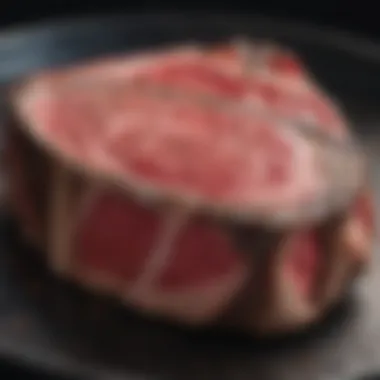
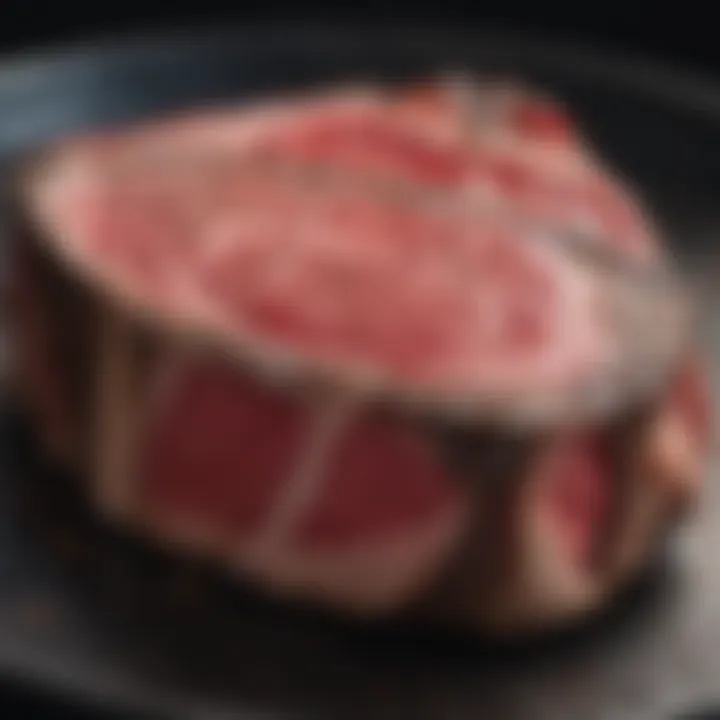
Intro
Cooking a steak in an iron skillet is an art that combines simplicity with skill. The iron skillet, known for its heat retention and even cooking, elevates the experience of preparing steak. This method not only enhances the flavor but also allows for superior crust formation and texture. Understanding the nuances of this technique can lead to delicious results. Each step, from selecting the right cut of meat to the final resting phase, contributes to the overall quality of the steak.
Key Benefits
Cooking steak in an iron skillet offers several advantages. First, the direct heat provides a perfect sear that locks in juices, enhancing the flavor of the meat. This high-heat cooking method promotes Maillard reaction, which infuses rich flavors into the steak.
Physical Health Benefits
Steak is a great source of protein, essential for muscle building and repair. It is also abundant in vitamins and minerals like iron, zinc, and vitamin B12. Moreover, preparing steak in an iron skillet is often a healthier alternative to using multiple cooking vessels, as it minimizes cleaning and reduces the need for excess oil or fat.
Mental Well-being Enhancements
The act of cooking can be therapeutic. Engaging in meal preparation allows individuals to focus their minds and relax. The satisfaction from cooking a well-done steak can improve mood and provide a sense of accomplishment. Cooking, particularly with hands-on methods like using a skillet, engages the senses and enhances mindfulness.
Practical Tips
To prepare a steak effectively using an iron skillet, consider the following essential tips:
Effective Meal Planning
- Choose the right cut: Ribeye, sirloin, or filet mignon are excellent choices for skillet cooking.
- Preparation time: Allow the steak to reach room temperature for even cooking.
- Use high-quality seasoning: Simple salt and pepper can suffice, but consider adding garlic or rosemary for an extra flavor boost.
Cooking Steps
- Preheat the iron skillet.
- Season the steak generously on both sides.
- Add oil with a high smoke point, like canola or grapeseed.
- Place the steak in the skillet without crowding.
- Flip the steak only once to preserve juices.
- Use a meat thermometer to check for doneness.
The End
In summary, cooking steak in an iron skillet is not just a culinary task; it is a journey that encompasses health benefits and personal satisfaction. Understanding the method and nuances can lead to great meals, elevating both the cooking and dining experience. By embracing this technique, individuals can deepen their culinary skills while enjoying the rich flavor and robust texture that a perfectly cooked steak offers.
"The difference between a good steak and a great steak often lies in the cooking method. The iron skillet is indispensable."
Utilizing an iron skillet is a step towards mastering steak cooking, reaffirming its place in every kitchen.
Prolusion to Cooking Steak in an Iron Skillet
Cooking steak in an iron skillet is a method that has gained significant attention among culinary enthusiasts and professionals. This cooking approach brings forth a combination of heat retention, even cooking, and a distinctive flavor that sets it apart from many other methods. The merits of using an iron skillet for steak preparation are manifold and merit thorough exploration.
One core advantage is the ability of an iron skillet to reach and maintain high temperatures. When a skillet is preheated properly, it creates a perfect environment for achieving that coveted sear on the steak. The Maillard reaction, which occurs when proteins react with sugars under heat, imparts a rich, complex flavor to the meat.
Moreover, the durability of iron skillets allows them to be used for a variety of cooking scenarios beyond steak. They are renowned for their resilience and can endure years of proper care. For those serious about their culinary skills, having an iron skillet is an investment that offers long-term benefits.
"Cooking is a universal language, and the iron skillet speaks fluently. It connects the cook to the food, fostering a deeper understanding of culinary skills."
Choosing the right cut and preparation techniques are crucial parts of this process. Selecting quality meat can profoundly affect the outcome of the dish. With the right knowledge in hand, anyone can elevate their cooking abilities substantially. By the end of this guide, readers will understand the fundamental principles of creating a perfectly cooked steak in an iron skillet, making it a worthwhile addition to any culinary discussion.
Understanding Iron Skillets and Their Advantages
Cooking steak in an iron skillet offers multiple benefits that enhance both the cooking process and the final result. Understanding these advantages can significantly impact how one approaches the task of cooking steak. Iron skillets are revered not just for their performance but also for their versatility and durability.
Heat Retention and Distribution
Iron skillets excel in heat retention and distribution. When an iron skillet heats up, it retains that heat exceptionally well, allowing for a consistent cooking temperature. This feature is crucial when searing steak, as it ensures even cooking, creating a nice crust while keeping the inside tender. A well-heated skillet can help achieve the Maillard reaction, which is responsible for developing rich flavors in cooked meat.
While cooking, the even distribution of heat prevents hot spots, which can lead to unevenly cooked steak. To maximize the retention of heat, always pre-heat your skillet prior to cooking. This way, the steak sears quickly and forms an appealing crust while locking in juices.
Durability and Longevity
Iron skillets are highly durable and can last for generations if cared for properly. Unlike many other materials, they can withstand high temperatures and are less likely to warp. This is particularly attractive for those who utilize their cookware frequently.
Moreover, the longevity of an iron skillet contributes to its value in a kitchen. With the proper cleaning and seasoning, the skillet develops a natural non-stick surface, enhancing its function over time. Investing in quality iron skillets equates to a long-term gain in cooking functionality.
Versatility Beyond Steak
An iron skillet isn't limited to simply cooking steak; its versatility spans a variety of cooking methods and dishes. From sautéing vegetables to baking cornbread, an iron skillet is a multi-functional tool that can handle numerous culinary tasks. This adaptability makes it a staple in many kitchens, as it encourages a diverse range of meal preparations.
Using an iron skillet can alter how other ingredients interact. For instance, its ability to retain heat can be harnessed for oven dishes, frying, or even slow-cooking stews. Its versatility not only aids in cooking steak but also in efficiently preparing sides that complement your meal.
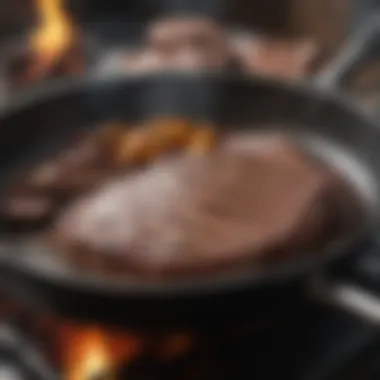
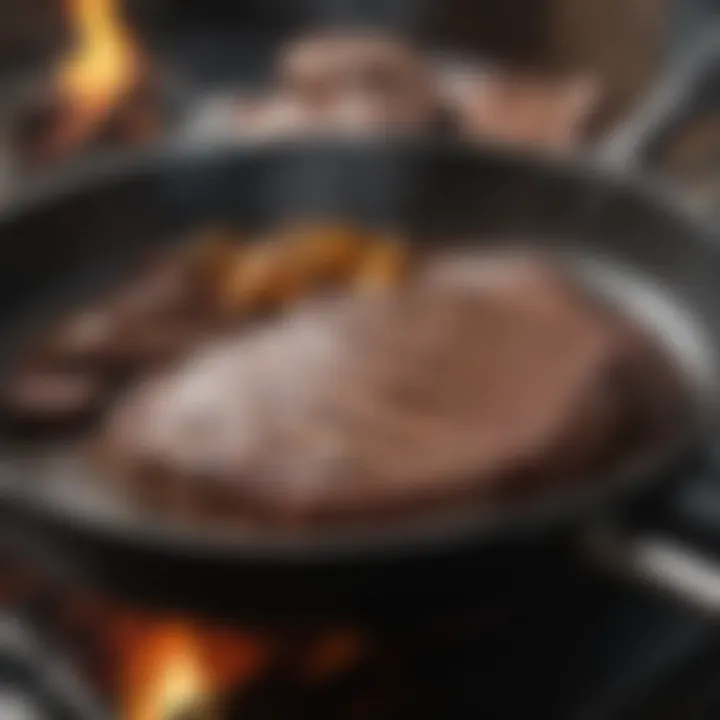
Selecting the Right Cut of Steak
Choosing the right cut of steak is fundamental when cooking it in an iron skillet. The cut directly influences not only the flavor but also the texture and overall cooking experience. Each cut offers unique attributes that contribute to the final dish. Understanding these differences helps in making an informed decision, enhancing both the quality of the meal and the satisfaction of the cook. Moreover, the right selection can immensely elevate the dining experience, ensuring that you achieve the desired taste, tenderness, and juiciness when the steak is served.
Popular Cuts
Ribeye
Ribeye is often celebrated for its rich marbling and robust flavor. The fat content in this cut plays a significant role in its tenderness and juiciness. Cooking ribeye in an iron skillet allows the marbled fat to render beautifully, basting the meat as it cooks. This creates a succulent piece that leaves a lasting impression. However, it is essential to note that ribeye can be more calorie-dense compared to leaner cuts. Therefore, it might not be the best choice for those with specific dietary restrictions but remains a popular option for its flavor complexity.
Sirloin
Sirloin presents a more affordable alternative to ribeye while still offering good flavor. It is a leaner cut, which means there is less fat, contributing to a less juicy experience. However, it can be cooked to a beautiful medium-rare, which maximizes its flavor potential. When properly seasoned and seared, sirloin can provide a satisfying steak experience. Nonetheless, its lack of marbling may require careful cooking to avoid dryness, making it necessary to monitor it closely in the skillet.
T-Bone
The T-bone cut is unique due to its combination of tenderloin and strip steak separated by a T-shaped bone. This duality offers the best of both worlds: the tenderness of the filet mignon and the flavor of the strip steak. Cooking a T-bone in an iron skillet can yield satisfying results, especially if you wish to indulge in the unique textures. However, its large size may lead to uneven cooking if not placed correctly in the skillet. Proper management of temperature and time is crucial to prevent one side from overcooking.
Filet Mignon
Filet mignon is widely recognized as one of the most tender cuts of beef. Its delicate texture is ideal for those who prioritize tenderness over a strong beefy flavor. When cooked in an iron skillet, filet mignon can develop a lovely crust while remaining tender inside. The downside is that it is generally more expensive, making it a less frequent choice for casual meals. However, its flavor profile can be exquisite when complemented with the right seasoning or sauces.
Considerations for Thickness
Thickness is a pivotal factor when selecting steak cuts. A thicker cut may require longer cooking times and can be easier to achieve a perfect sear while keeping the inside juicy. But if the cut is excessively thick, it may lead to undercooked meat in the center. Conversely, thinner cuts can cook quickly but might lose moisture and flavor. Aiming for a cut that is about one inch thick often presents a good balance for achieving the desired flavor and texture in an iron skillet.
Choosing Quality Meat
Quality of meat must not be overlooked. A well-marbled steak, regardless of the cut, tends to yield better flavor and juiciness. Look for steaks that have a rich red color and some visible fat, as these indicators often signify quality. It is advisable to purchase meat from reliable sources, such as local butcher shops or trusted grocery stores. This choice can make a significant difference in the overall cooking experience.
Essential Tools and Ingredients
Cooking a steak in an iron skillet requires the right tools and ingredients. These components are essential to achieving perfect flavor and texture. By carefully considering what you use, you enhance the quality of the final dish. An iron skillet is known for its ability to retain heat, which is crucial when searing steak. In addition to the skillet, specific utensils and ingredients play a significant role in the cooking process.
Required Cooking Utensils
Iron Skillet
An iron skillet is a fundamental tool when cooking steak. Its main characteristic is the ability to retain high heat for extended periods. This quality enables a perfect sear, which is essential to develop rich flavors in the meat. Iron skillets are also durable and versatile. They can go from stovetop to oven, making them ideal for various cooking techniques. The only disadvantage can be their weight, which may be an issue for some cooks.
Meat Thermometer
A meat thermometer is another crucial tool for cooking steak. This device assures that you achieve the desired doneness without guessing. A reliable meat thermometer can provide accurate readings quickly and efficiently. Many thermometers come with a probe that allows you to monitor the internal temperature of the steak. This specificity improves the outcome significantly. The drawback may be the need for battery replacements, but the benefits far outweigh this inconvenience.
Tongs
Tongs are important for handling the steak during the cooking process. They allow for a secure grip, making it easy to turn the meat without piercing it. This is critical as piercing can cause juices to escape, resulting in a dry steak. Quality tongs often have a heat-resistant grip, which adds to their usability. However, a poorly designed pair can make it challenging to handle food effectively.
Seasoning and Marinades
Seasoning and marinades elevate the flavor profile of your steak. Simple seasonings, such as sea salt and black pepper, can enhance the meat's natural flavors. If you prefer marinades, consider those that complement the cut of steak you choose. Ingredients like garlic, herbs, and olive oil can add depth to the taste. The effectiveness of these can depend on marinating time. A longer marinating period usually results in enhanced flavor, but over-marinating can alter the meat's texture.
Choosing the right combination of tools and ingredients will greatly impact the steak's final outcome. Preparation is as crucial as cooking, so investing time in these elements will pay dividends when you serve your meal.
Preparing the Steak for Cooking
In the process of cooking a steak in an iron skillet, proper preparation is essential. The right preparation not only boosts the steak’s flavor but also enhances its texture. When a steak is not prepared adequately, issues such as uneven cooking and less flavorful meat can arise. Therefore, understanding the steps to effectively prepare your steak is crucial.
Bringing the Steak to Room Temperature
It is essential to let your steak come to room temperature before cooking. Cold meat can lead to two significant issues: an uneven internal temperature and longer cooking times. By allowing the steak to rest outside of the refrigerator for about 30 to 60 minutes, you will help ensure that it cooks more evenly.
When only the outside of the steak gets hot, it can lead to a raw center while the exterior becomes overcooked. This can ruin the desired texture and flavor profile, leaving you with a less-than-ideal meal. Furthermore, letting the meat rest allows enzymes to break down proteins, which contributes to a more tender result.
Applying Seasoning
Seasoning is a critical step in preparing your steak. The choice of seasoning can greatly influence the final taste of the dish. A simple method to enhance the natural flavors is to use salt and black pepper. Application should ideally happen right before cooking. Salt draws moisture from the steak, which will help create a nice crust on the outside. However, applying it too early can lead to a dry steak.
You may also choose to incorporate other spices, which can add depth to the flavor. Herbs like rosemary and thyme, or a mix of garlic and onion powder can complement the steak well. Marinades can also be effective if you wish for more intense flavor. Letting the steak marinate for a few hours can further enhance its taste and tenderness. However, be cautious with acidic marinades as prolonged exposure can lead to a mushy texture.
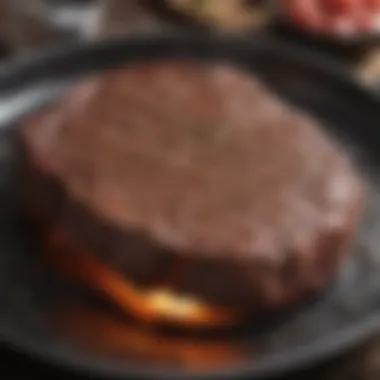
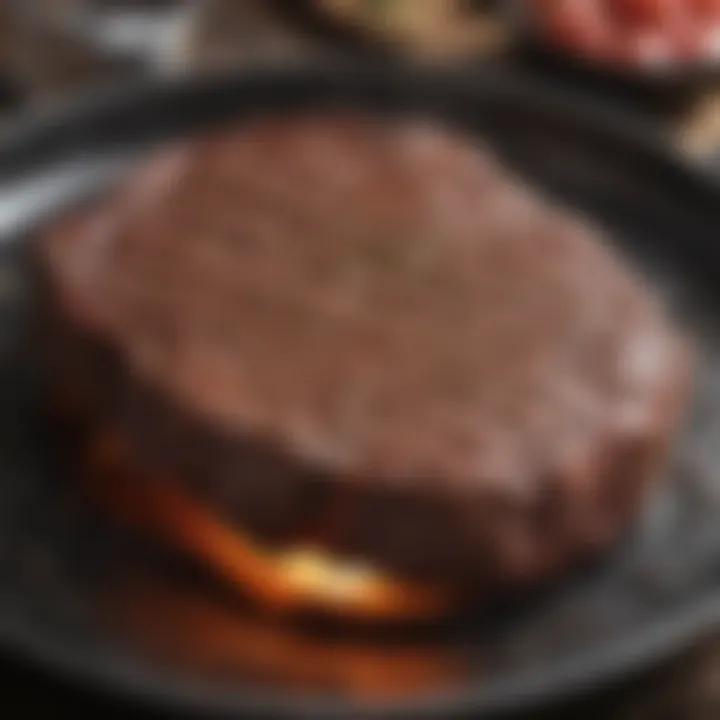
In summary, preparation steps like allowing the steak to reach room temperature and applying appropriate seasonings are vital for achieving optimal flavor and texture. Following these steps will set a solid foundation for the cooking process.
The Cooking Process
The cooking process is the cornerstone of achieving a well-cooked steak. It involves multiple steps, each playing a critical role in ensuring flavor and texture. Mastery of this process enhances the overall experience of cooking and enjoying steak. Key elements include the initial preheating of the skillet, the crucial searing step, adding richness through basting, and finally determining the doneness to match personal preferences. Each element requires attention to detail and a solid understanding of technique.
Preheating the Skillet
Preheating the skillet is an essential step that should not be overlooked. An iron skillet retains heat exceptionally well, which is vital for searing steak. When the skillet is heated properly, it creates a crust that locks in moisture and flavor. Ideally, the skillet should be heated over medium-high heat for several minutes until it is ready for the steak.
To test if the skillet is hot enough, a drop of water should sizzle and evaporate immediately upon contact. This indicates that the temperature is right for cooking. If the skillet is not hot enough, the steak will stick, and the desired sear will be difficult to achieve.
Searing the Steak
Searing is where the magic happens. It is important to place the steak in the skillet only when it is adequately preheated. Introduce the steak gently to avoid splatter, and ensure good contact with the skillet surface. Searing not only develops deeper flavors through the Maillard reaction, but it also creates an appealing crust. Depending on the thickness of the steak, searing for about two to three minutes on each side usually suffices.
Tips for a successful sear:
- Avoid moving the steak around in the pan. Let it sit undisturbed to achieve a proper sear.
- Season appropriately before this step for enhanced flavor.
Basting for Added Flavor
Basting significantly enhances the flavor of your steak. This technique involves spooning hot fat, such as butter or oil, over the steak while it cooks. It helps to develop a richer taste and improves the moisture content. Using aromatics like garlic and herbs in the basting fat can elevate the flavor profile even further.
To properly baste, tilt the skillet slightly after adding the fat and use a spoon to gather it. Continuously pour it over the steak repeatedly for the best results. This is particularly effective in the last few minutes of cooking, creating a harmonious blend of flavors within the meat itself.
Checking for Doneness
Determining the ideal level of doneness is crucial for achieving the perfect steak. Various methods can be used, like the touch test, where you compare the firmness of the steak to different parts of your hand. However, using a meat thermometer is a much more reliable approach.
Temperature guide for steak doneness:
- Rare: 120°F to 130°F
- Medium Rare: 130°F to 140°F
- Medium: 140°F to 150°F
- Medium Well: 150°F to 160°F
- Well Done: 160°F and above
Insert the thermometer into the thickest part of the steak, avoiding any bones. Once the desired temperature is reached, remove the steak from the skillet and allow it to rest before slicing. Resting allows the juices to redistribute, enhancing the overall flavor and texture.
Remember, each step in the cooking process builds upon the last. Disregarding any detail can impact the final outcome.
Post-Cooking Considerations
In the cooking process of a steak, the post-cooking phase is often overlooked. However, this stage plays a crucial role in maximizing the overall dining experience. Key elements like resting the steak and slicing techniques directly influence flavor, texture, and juiciness. Undoubtedly, neglecting these considerations can lead to less satisfactory results.
Resting the Steak
Resting the steak after cooking is a vital step that should not be bypassed. When steak cooks, the heat forces juices towards the center. If you cut into the steak immediately, these juices escape, resulting in a dry texture. Allowing the steak to rest redistributes these juices, promoting a much juicier and flavorful result. A good rule of thumb is to let the steak rest for at least five to ten minutes. This time gives the meat a chance to relax.
To rest the meat properly, place it on a cutting board and cover it loosely with foil. This will keep it warm without steaming. The thickness of the steak can affect resting time; thicker cuts may require longer to be at their best. During this resting phase, the flavor compounds settle, intensifying the overall taste.
Slicing Techniques
Proper slicing is essential for achieving the best enjoyment from your steak. To ensure tenderness, always slice against the grain. Understanding the grain of the meat, which is the direction the muscle fibers run, will help you make the right cuts. Slicing against the grain shortens the fibers, making each bite easier to chew and enhancing the perception of flavor.
When preparing to slice, use a sharp knife to ensure clean cuts. Dull knives can tear the meat, compromising texture.
Here are some guidelines for slicing your steak:
- Allow the steak to rest for the optimum time.
- Identify the grain direction clearly.
- Hold the steak steady with a fork or your hands, if comfortable.
- Make even, smooth cuts, approximately half an inch thick.
"Slicing against the grain not only enhances tenderness but also elevates the tasting experience."
This post-cooking stage is often neglected but can dramatically improve your steak's enjoyment. Paying attention to resting and slicing techniques is essential for achieving a restaurant-quality meal at home.
Common Mistakes to Avoid
When cooking steak in an iron skillet, understanding common mistakes is crucial. Each misstep can compromise the quality and flavor of the final dish. Avoiding these pitfalls ensures that every steak you prepare is not only enjoyable but also cooked to perfection. Key mistakes can range from issues related to overcrowding to neglecting essential resting time. Addressing these elements helps maintain the steak's texture, flavor, and moisture, resulting in a more satisfying meal.
Overcrowding the Pan
Overcrowding the skillet is one of the most frequent errors made when cooking steak. This mistake arises when too many pieces of meat are added to the pan at once, preventing adequate heat circulation. When heat cannot reach every surface of the steak, it leads to steaming rather than searing. The desired crust that forms on a well-cooked steak may fail to develop. To avoid this, it is advisable to cook one or two steaks at a time depending on the skillet size.
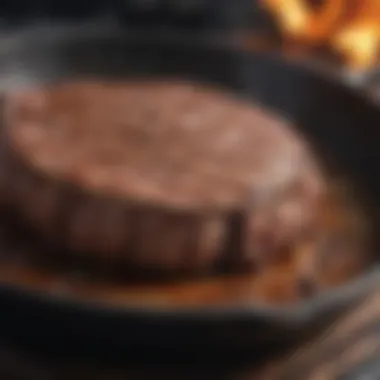
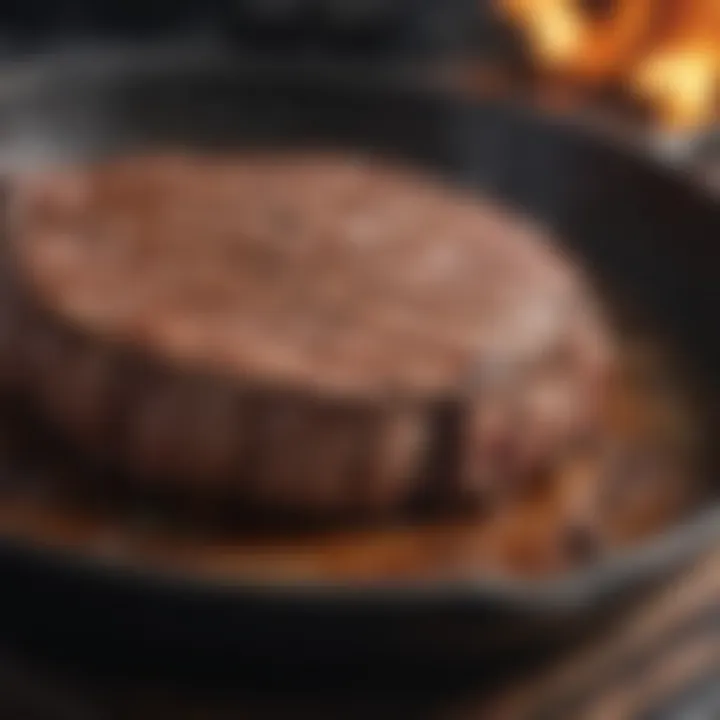
Additionally, overcrowding can lead to uneven cooking. Certain areas of the steak might receive more heat, resulting in a lack of consistency in doneness. For optimal searing, you should ensure that there is enough space between each piece of meat. This allows the heat to circulate uniformly, promoting even cooking and creating that essential Maillard reaction that develops rich flavors and textures.
"Searing creates flavor. Avoid overcrowding, and allow your steaks to shine!"
Not Allowing for Rest Time
Resting a steak after cooking is equally as important as the cooking process itself. Many people skip this step, thinking they can dive straight into enjoying a meal. However, failing to let a steak rest can result in a dry texture. When cooked, the juices within the steak move towards the surface. If you cut into the meat immediately, these flavorful juices will escape, leading to a loss of moisture.
Resting allows these juices to redistribute throughout the steak. A good rule of thumb is to let the steak sit for about five to ten minutes, depending on its size. Cover it loosely with aluminum foil during this time to retain warmth without causing the steak to sweat.
In summary, avoiding these common mistakes will enhance your skills in cooking steak with an iron skillet. Focus on managing the number of steaks in the pan and prioritize resting time to achieve a flavorful, juicy result.
Reinforcing Flavor with Sauces and Sides
Cooking steak in an iron skillet is an art form in itself, but the journey does not end with the perfect sear. The flavors can be elevated further with well-prepared sauces and thoughtfully selected side dishes. This section will discuss the impact of sauces and sides on the overall steak experience, highlighting how they can enhance both taste and presentation. Food pairing plays a critical role in creating a harmonious meal that balances richness with freshness, which engages the palate in varied textures and flavors.
Preparing Complementary Sauces
Red Wine Reduction
The red wine reduction is a classic choice for complementing steak. This sauce involves simmering red wine along with aromatics and broth to create a rich, concentrated flavor. The acidity from the wine cuts through the richness of the steak, bringing a balance to the dish. The key characteristic of a red wine reduction is its depth, allowing the flavors from the meat to meld seamlessly with the sauce. This makes it a highly beneficial option, especially for those who appreciate robust flavors. The unique feature of this reduction is its ability to transform simple ingredients into a complex and elegant sauce. One disadvantage is that it requires time to achieve the right consistency, which may not suit every cook's timeline. However, the effort often pays off in a heightened culinary experience.
Chimichurri
Chimichurri is another excellent addition to a steak meal. This fresh, herby sauce from Argentina uses parsley, garlic, vinegar, and olive oil, providing a vibrant contrast to the hearty steak. A significant benefit of chimichurri is its freshness, which can brighten even the richest cuts of meat. It adds a layer of flavor that is both vibrant and acidic, making it very popular in various culinary settings. The unique feature of chimichurri is its versatility; it can be prepared in advance and served cold, making it easy to incorporate into meal prep. However, one consideration is ensuring that the balance of garlic and vinegar does not overpower the steak. When used thoughtfully, chimichurri can elevate the meal without overshadowing the primary flavors.
Ideal Side Dishes
Grilled Vegetables
Grilled vegetables serve as an ideal accompaniment to steak, providing a colorful and nutritious contrast. The specific aspect of grilled vegetables is their flavor enhancement through caramelization, which brings out their natural sweetness. This makes them a highly beneficial choice, as they offer texture, color, and nutrients that complement the meat well. One advantage is that they can be prepared quickly, often in the same skillet or on the grill, allowing for ease in cooking. On the downside, careful seasoning is required to ensure that the vegetables do not overpower the steak.
Mashed Potatoes
Mashed potatoes are a traditional side dish that pairs beautifully with steak. Their creamy texture provides a wonderful contrast to the meat's firmness. The key characteristic of mashed potatoes is their comfort food appeal, making them a popular choice among many. They can absorb sauces and flavors, further enhancing the overall meal experience. A unique feature is their adaptability; they can be enriched with cream, butter, or even garlic to enhance their presence on the plate. A disadvantage is that if not properly seasoned, they can become bland. Attention must be given to their preparation to ensure they balance well with the steak's robust flavors.
Cleaning and Maintenance of Iron Skillets
Maintaining an iron skillet is essential for its longevity and functionality. Proper cleaning and seasoning contribute not only to the skillet's performance but also to the flavor of the dishes prepared in it. An iron skillet, when maintained well, can last for generations, becoming better with use. It develops a natural non-stick surface through seasoning, which enhances the cooking experience. For health professionals, wellness coaches, nutritionists, fitness trainers, and mindfulness instructors, understanding the cleaning and maintenance of iron skillets can support discussions on sustainable cooking and healthy eating habits.
Cleaning Methodology
Cleaning an iron skillet is straightforward yet must be done correctly to avoid rust and maintain its seasoning. Follow these steps for effective cleaning:
- Let the Skillet Cool: Always allow your skillet to cool slightly before cleaning. Sudden temperature changes can cause warping.
- Use Minimal Water: Rinse the skillet with warm water. Avoid soaking it as that can cause rust.
- Scrub with a Brush: Utilize a stiff brush or a non-metal scrubber to remove food residues. For stubborn bits, use coarse salt as a gentle abrasive.
- Dry Immediately: After rinsing, dry the skillet thoroughly with a clean cloth or paper towel. This step is crucial to prevent rust formation.
- Apply a Light Coat of Oil: Once dry, apply a small amount of cooking oil to prevent moisture from binding to the metal. Wipe off excess oil with a towel.
These practices maintain not only the skillet's performance but also its ability to impart flavors to your meals.
Seasoning Your Skillet
Seasoning is a vital process in maintaining the non-stick surface and the overall health of your iron skillet. Here is how to season it:
- Preheat the Oven: Set your oven to 375°F (190°C).
- Clean the Skillet: Make sure your skillet is clean and completely dry before starting.
- Apply Oil: Use a high-smoke point oil such as grapeseed oil or flaxseed oil. Apply a thin layer over the entire surface of the skillet.
- Bake Upside Down: Place the skillet upside down in the oven for an hour. This prevents oil pooling in the bottom.
- Cool in the Oven: After an hour, turn off the oven and allow the skillet to cool inside. This helps the seasoning bond with the pan.
Regularly seasoning your iron skillet enhances its non-stick capability and protects it from rust. It is a simple yet effective way to ensure your skillet remains a valuable tool in your kitchen for years to come.
Finale: Elevating Your Cooking Skills
In the realm of culinary arts, mastering the technique of cooking steak in an iron skillet is a vital skill. It embodies principles that not only apply to steak but enhance overall cooking abilities. This article sheds light on the nuances of this practice, offering insights beneficial to every level of cooking expertise.
Understanding the methodical process involved allows aspiring cooks and seasoned chefs alike to respect the ingredients and the tools. The iron skillet, with its remarkable heat retention, becomes an extension of the cook's hands. Familiarity with this tool elevates the cooking experience, enabling cooks to achieve a level of precision previously thought unattainable.
Key Benefits of Learning This Skill
- Consistency in Cooking: Knowing how to control the heat and timing can significantly improve the taste and texture of each steak.
- Flavor Development: Techniques such as seasoning, basting, and sauce preparation contribute to a rich flavor profile that can please a variety of palates.
- Resourcefulness: Armed with the knowledge from this guide, cooks can apply similar principles to other meats and vegetables.
Moreover, avoiding common mistakes enhances the learning curve. Recognizing the importance of resting time allows the cook to serve a steak that's both juicy and tender.
"Cooking is about confidence. Master one technique and the rest becomes easier."
It's also crucial to appreciate the cultural and historical context of using an iron skillet. Embracing tradition while incorporating modern techniques fosters a deeper connection to food.
Considerations for Continued Growth
- Experimentation: Try new cuts of steak or different seasoning methods to expand your culinary repertoire.
- Feedback: Engage with others to gather insights on your cooking; this can lead to significant improvements in skills.
- Education: Constantly seek resources—books, videos, or cooking classes—that can refine your abilities further.
The skills gained from cooking steak in an iron skillet transcend the kitchen. They cultivate patience, precision, and creativity. As you elevate your cooking skills, you contribute to a larger appreciation for food, nurturing not just your own culinary journey but perhaps inspiring others along the way.















